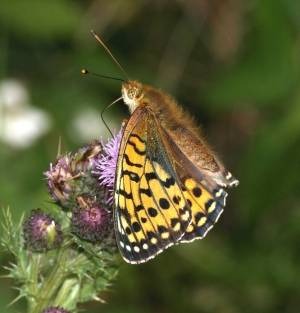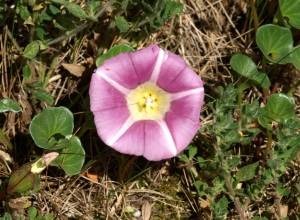Dr Phil Smith’s Wildlife Notes
July 2010
United Utilities’ introduction of a hose-pipe ban on 9th July led inevitably to the “Great Drought” ending in the middle of the month; it soon became a distant memory as frequent spells of rain came in from the Atlantic. Parts of Birkdale Green Beach reflooded, with Natterjacks Toads calling on the unusually late date of 23rd July. As in July 2007, they must have spawned because I found lots of baby tadpoles on the 31st in shallow water at the Ainsdale end of the Green Beach.
Following an early emergence in late June, our most important duneland butterfly, the Dark Green Fritillary, reached unprecedented numbers, appearing in areas where they have rarely been seen before. Rachael Parks contacted me to report four sightings in her Formby garden where, in past years, she has recorded only one. My visit to Ainsdale dunes on 11th was rewarded by the sight of dozens of these spectacular orange-and-black butterflies zooming around at high speed, posing for photographs on thistles, brambles and knapweed, together with Commas, Gatekeepers, Meadow Browns and Small Skippers and the first Graylings of the summer. A nearby pond produced seven species of dragonflies, including an early Ruddy Darter.

During June and July, Liverpool Hope University hosted a visit by the coastal ecologist Dr Maike Isermann from Bremen, studying the effects of scrub removal on the sand-dunes. I had the pleasure of showing Maike some of our best dune areas, including many plants and animals that were new to her. It was especially valuable to get her opinion on the potential problem of Japanese Rose (Rosa rugosa), a garden-escape which has become seriously invasive on sand-dunes in Germany and Denmark and seems about to become a major problem here. We have organised a student project which will collect information on its distribution and rate of spread, with the aim of guiding future management.
Maike was particularly interested to see the famous shingle beach at Hightown. Here, erosion of a tipped rubble embankment has produced a unique habitat of water-worn bricks, colonised by such typical shingle plants as Yellow-horned Poppy, Sea-kale and Rock Samphire. We also found an abundance of another regionally rare plant – Ray’s Knot-grass. Vegetated shingle is a rare habitat in Northwest England, meriting conservation throughout Europe.
One of our most beautiful duneland flowers, the Sea Bindweed (Calystegia soldanella) has been highlighted for special study by the Lancashire Wildlife Trust’s Endangered Plants Group. Pat Lockwood and I therefore monitored six colonies on the Sefton Coast during July. We already knew the whereabouts of five of them but not one on Ainsdale Local Nature Reserve which was originally found in 1949. By coincidence, Maike Isermann came across it during her researches and provided us with a grid reference. First recorded on the dunes here in 1801, Sea Bindweed was familiar to several 19th century writers but, by the 1960s, had become “very rare”. Fortunately, it has survived and may even be increasing, several new Sefton Coast colonies having been discovered in recent years.

July is often a quiet period for birdwatchers but seabirds were already on the move before the month’s end, with a sizeable shore roost of about 180 Sandwich Terns and 550 Common Terns at Ravenmeols on 28th and at least 185 of the former species at Ainsdale three days later. It was good to see so many juvenile Sandwich Terns with the flocks, indicating a good breeding season.
